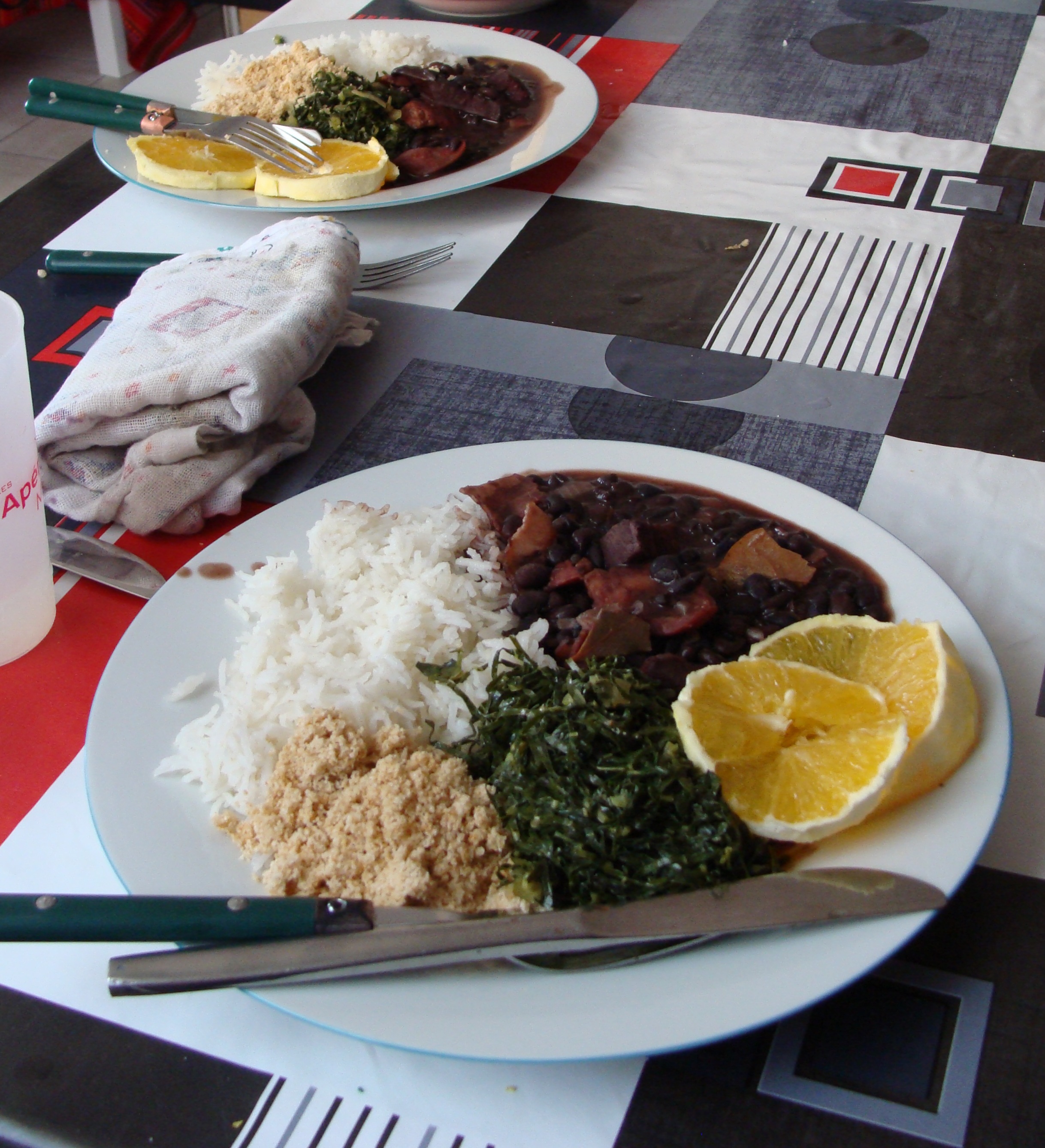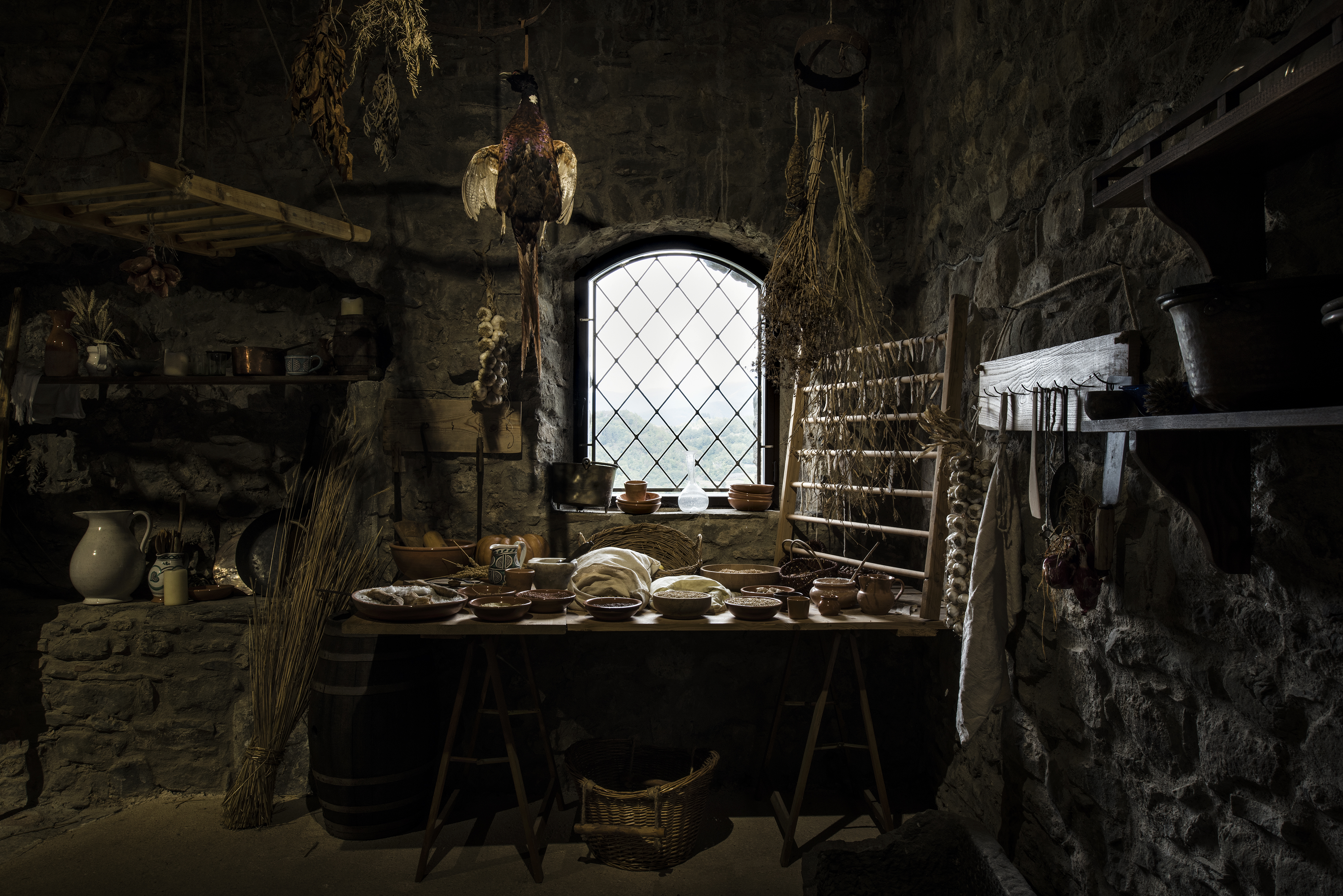|
Feijão Tropeiro
Feijão tropeiro, also known as feijão caipira, feijão de preguiça and feijão das onze, is a typical dish from Paulista cuisine. It consists of beans mixed with cassava or maize flour, sausage, eggs, bacon or toucinho, seasoned with garlic, onion, parsley and peppercorn, and is sometimes enriched with chicharrón and brassica oleracea. Initially, the most common way of cooking it was in an improvised trempe, as it was prepared on expeditions to the backlands by bandeirantes and later by tropeiros. It would become a traditional dish in the region explored by bandeirantes and tropeiros. As well as São Paulo, today it is also present in the traditional cuisine of Goiás, Minas Gerais, Mato Grosso and Paraná. History Origins The dish has its origins in the 17th century. Its name comes from the '' tropeiros'' – merchants who sold horses, mules, and food between the south and southeast regions of Brazil. The typical dish were originally created before tropeiros, during the t ... [...More Info...] [...Related Items...] OR: [Wikipedia] [Google] [Baidu] |
Brazilian Cuisine
Brazilian cuisine is the set of cooking practices and traditions of Brazil, and is characterized by European cuisine, European, Amerindian, African tribes, African, and Asian (Levantine cuisine, Levantine, Japanese food, Japanese, and most recently, Chinese food, Chinese) influences. It varies greatly by region, reflecting the country's mix of native and immigrant populations, and its continental size as well. This has created a national cuisine marked by the preservation of regional differences. Ingredients first used by native peoples in Brazil include cashews, cassava, ''guaraná'', ''açaí'', ''Dipteryx odorata, cumaru,'' and ''tucupi''. From there, the many waves of immigrants brought some of their typical dishes, replacing missing ingredients with local equivalents. For instance, the European immigrants (primarily from Portuguese Brazilian, Portugal, Italian Brazilian, Italy, Brazilians of Spanish descent, Spain, German Brazilian, Germany, Dutch Brazilian, Netherlands, Po ... [...More Info...] [...Related Items...] OR: [Wikipedia] [Google] [Baidu] |
São Paulo (state)
São Paulo (, ) is one of the Federative units of Brazil, 26 states of the Brazil, Federative Republic of Brazil and is named after Paul the Apostle, Saint Paul of Tarsus. It is located in the Southeast Region, Brazil, Southeast Region and is bordered by the states of Minas Gerais to the north and northeast, Paraná (state), Paraná to the south, Rio de Janeiro (state), Rio de Janeiro to the east and Mato Grosso do Sul to the west, in addition to the Atlantic Ocean to the southeast. It is divided into List of municipalities in São Paulo, 645 municipalities. The total area is km2, which is equivalent to 2.9% of Brazil's surface, being slightly larger than the United Kingdom. Its capital is the São Paulo, municipality of São Paulo. With more than 44 million inhabitants in 2022, São Paulo is the Federative units of Brazil#List, most populous Brazilian state (around 22% of the Brazilian population), the List of first-level administrative divisions by population, world's 28th-mos ... [...More Info...] [...Related Items...] OR: [Wikipedia] [Google] [Baidu] |
Feijao Tropeiro And Side Dishes '', the common bean
{{disambig ...
Feijao is derived from feijão, the Portuguese word for bean. It most commonly refers to: * ''Feijoa sellowiana'', a fruit also known as guavasteen or pineapple guava * ''Phaseolus vulgaris ''Phaseolus vulgaris'', the common bean,, is a herbaceous annual plant grown worldwide for its edible dry seeds or green, unripe pods. Its leaf is also occasionally used as a vegetable and the straw as fodder. Its botanical classification, alo ... [...More Info...] [...Related Items...] OR: [Wikipedia] [Google] [Baidu] |
Indigenous Peoples Of The Americas
In the Americas, Indigenous peoples comprise the two continents' pre-Columbian inhabitants, as well as the ethnic groups that identify with them in the 15th century, as well as the ethnic groups that identify with the pre-Columbian population of the Americas as such. These populations exhibit significant diversity; some Indigenous peoples were historically hunter-gatherers, while others practiced agriculture and aquaculture. Various Indigenous societies developed complex social structures, including pre-contact monumental architecture, organized city, cities, city-states, chiefdoms, state (polity), states, monarchy, kingdoms, republics, confederation, confederacies, and empires. These societies possessed varying levels of knowledge in fields such as Pre-Columbian engineering in the Americas, engineering, Pre-Columbian architecture, architecture, mathematics, astronomy, History of writing, writing, physics, medicine, Pre-Columbian agriculture, agriculture, irrigation, geology, minin ... [...More Info...] [...Related Items...] OR: [Wikipedia] [Google] [Baidu] |
European Cuisine
European cuisine (also known as Continental cuisine) comprises the cuisines originating from the various countries of Europe. The cuisines of European countries are diverse, although some common characteristics distinguish them from those of other regions.Kwan Shuk-yan (1988). ''Selected Occidental Cookeries and Delicacies'', p. 23. Hong Kong: Food Paradise Pub. Co. Compared to traditional cooking of East Asia, meat holds a more prominent and substantial role in serving size.Lin Ch'ing (1977). ''First Steps to European Cooking'', p. 5. Hong Kong: Wan Li Pub. Co. Many dairy products are utilised in cooking. There are hundreds of varieties of cheese and other fermented milk products. White wheat-flour bread has long been the prestige starch, but historically, most people ate bread, flatcakes, or porridge made from rye, spelt, barley, and oats. Those better-off would also make pasta, dumplings and pastries. The potato has become a major starch plant in the diet of Europeans an ... [...More Info...] [...Related Items...] OR: [Wikipedia] [Google] [Baidu] |
English Language
English is a West Germanic language that developed in early medieval England and has since become a English as a lingua franca, global lingua franca. The namesake of the language is the Angles (tribe), Angles, one of the Germanic peoples that Anglo-Saxon settlement of Britain, migrated to Britain after its End of Roman rule in Britain, Roman occupiers left. English is the list of languages by total number of speakers, most spoken language in the world, primarily due to the global influences of the former British Empire (succeeded by the Commonwealth of Nations) and the United States. English is the list of languages by number of native speakers, third-most spoken native language, after Mandarin Chinese and Spanish language, Spanish; it is also the most widely learned second language in the world, with more second-language speakers than native speakers. English is either the official language or one of the official languages in list of countries and territories where English ... [...More Info...] [...Related Items...] OR: [Wikipedia] [Google] [Baidu] |
Colonial Brazil
Colonial Brazil (), sometimes referred to as Portuguese America, comprises the period from 1500, with the Discovery of Brazil, arrival of the Portuguese, until 1815, when Brazil was elevated to a United Kingdom of Portugal, Brazil and the Algarves, kingdom in union with Portugal. During the 300 years of Brazilian colonial history, the main economic activities of the territory were based first on Paubrasilia, brazilwood extraction (brazilwood cycle), which gave the territory its name; sugar production (Brazilian sugar cycle, sugar cycle); and finally on gold and diamond mining (Brazilian Gold Rush, gold cycle). Slaves, especially those Atlantic slave trade to Brazil, brought from Africa, provided most of the workforce of the Brazilian export economy after a brief initial period of Indigenous slavery to cut brazilwood. In contrast to the neighboring Spanish America, Spanish possessions, which had several Viceroy, viceroyalties with jurisdiction initially over New Spain (Mexico) and V ... [...More Info...] [...Related Items...] OR: [Wikipedia] [Google] [Baidu] |
South America
South America is a continent entirely in the Western Hemisphere and mostly in the Southern Hemisphere, with a considerably smaller portion in the Northern Hemisphere. It can also be described as the southern Subregion#Americas, subregion of the Americas. South America is bordered on the west by the Pacific Ocean, on the north and east by the Atlantic Ocean, and to the south by the Drake Passage; North America and the Caribbean Sea lie to the northwest. The continent includes twelve sovereign states: Argentina, Bolivia, Brazil, Chile, Colombia, Ecuador, Guyana, Paraguay, Peru, Suriname, Uruguay, and Venezuela; two dependent territory, dependent territories: the Falkland Islands and South Georgia and the South Sandwich Islands; and one administrative division, internal territory: French Guiana. The Dutch Caribbean ABC islands (Leeward Antilles), ABC islands (Aruba, Bonaire, and Curaçao) and Trinidad and Tobago are geologically located on the South-American continental shel ... [...More Info...] [...Related Items...] OR: [Wikipedia] [Google] [Baidu] |
Food And Road
Food is any substance consumed by an organism for Nutrient, nutritional support. Food is usually of plant, animal, or Fungus, fungal origin and contains essential nutrients such as carbohydrates, fats, protein (nutrient), proteins, vitamins, or Mineral (nutrient), minerals. The substance is Ingestion, ingested by an organism and assimilated by the organism's Cell (biology), cells to provide energy, maintain life, or stimulate growth. Different species of animals have different List of feeding behaviours, feeding behaviours that satisfy the needs of their metabolisms and have evolved to fill a specific ecological niche within specific geographical contexts. Omnivore, Omnivorous humans are highly adaptable and have adapted to obtaining food in many different ecosystems. Humans generally use cooking to prepare food for consumption. The majority of the food energy required is supplied by the industrial food industry, which produces food through Intensive farming, intensive agricu ... [...More Info...] [...Related Items...] OR: [Wikipedia] [Google] [Baidu] |








